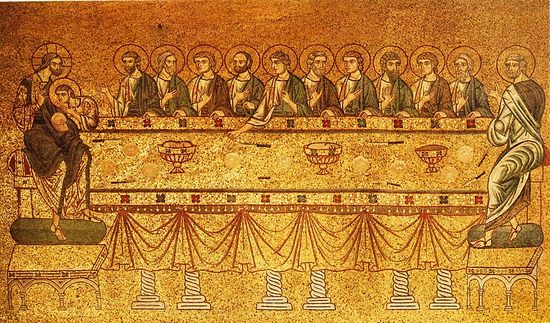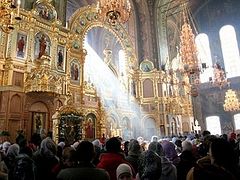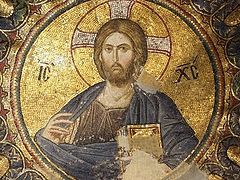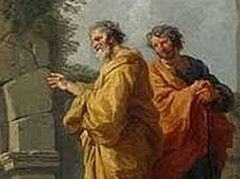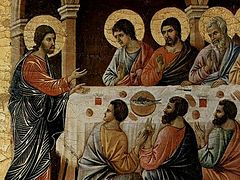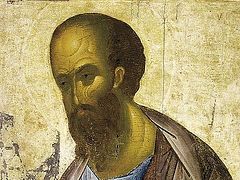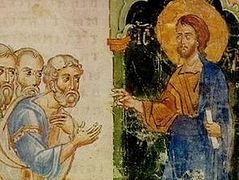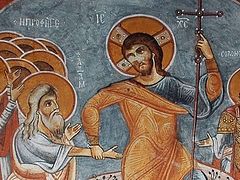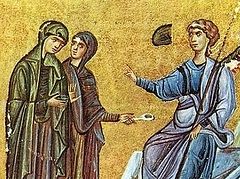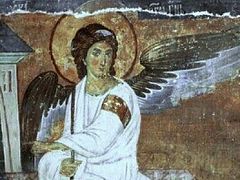See The Crucifixion of Christ, Part 1
The Passover
Now what about the timing of the Crucifixion? From the sixth hour to the ninth hour. You should know, of course, that the Passover was preceded by a number of days that were at the time of Christ a separate feast. Today the Passover consists of many days, but in those days, the earlier period was called The Feast of Unleavened Bread, and the Passover was just one day. In the time of Christ, on the year of Christ’s death, it was on a Saturday. But we see that the Lord was in charge of His execution, that He did all things willingly, that He did all things knowingly when He arranged where and when to eat the Passover meal. We know that the Passover meal took place on Thursday night, during the Feast of Unleavened Bread. The leavened bread was removed from the houses prior to the Feast of Passover, and we know that the Passover meal itself that Christ shared with His disciples, what we call the Last Supper, took place on the night before the actual Passover meal would ordinarily have been eaten, because the Passover meal was eaten on the night of Passover. That would have begun at sunset on the Friday on which Christ died; but we know that He ate the meal on Thursday.
Now we know that St. John’s Gospel is accurate. He is the one who tells us specifically that Christ was executed on the eve of the Passover, that is, on Friday. Passover was on Saturday. The synoptic Gospels—Matthew, Mark and Luke—are not so specific about this; they just speak in general about Christ’s death at “Passover.” Since we know that the Last Supper was a “Passover meal,” that’s why they presume or seem to suggest that He ate the Passover on Friday night and actually died on the day of Passover. And, of course, there’s tremendous meaning in the fact that the Lord died at Passover time. So the Synoptics are emphasizing that, but St. John is emphasizing something different in his Gospel. First of all, it makes sense that the Lord died on Friday. This is something we presume, but I’m telling you this was not discussed so much in the Early Church and John makes a point of saying that Christ died on the eve of Passover, on the Day of Preparation. First of all, the Jewish leaders would not have been running around on the day of Passover conducting a trial, taking Christ before Pilate, etc. So the Lord did not die on the actual day of Passover.
A couple of lessons back I asked you to think about why there was no lamb at the Passover meal that Christ shared with His disciples. From a strictly historical perspective, the reason was that they ate the Passover meal before the Passover; so there was no lamb, that’s true. The lambs were killed on Friday. They ate the meal on Thursday night. So at this Last Supper we have bread, wine and the bitter herbs —these are elements of the Passover meal. But there was no lamb. There is tremendous meaning, I think, in this, because Christ was the Lamb. So the Passover meal he shared with His disciples was different. It was the start of a new kind of Passover in which Christ was the Lamb. This also marks the end of ritual sacrifice, because Christ completely changes the nature and the meaning of Passover by His death at Passover time. Christ was the Lamb. This is the end of ritual sacrifice. From now on people would no longer worship God by killing irrational animals. The Christians would be the first people in the world not to kill animals as part of their worship. They instead would have spiritual worship. This is mentioned many, many times in the Fathers. They called it “logeiki latria,” “rational worship.” Sometimes it is translated as “spiritual worship,” or “reasonable worship.”
You see that it has tremendous meaning—the fact that the Lord died at Passover time. When He met with His disciples at the Last Supper He said to them, “Take, eat, this is my Body… And this is my Blood.” First of all, He made it so clear, so explicit, that this was His Body and Blood. It was absolutely a direct statement. It is ironic to me that many will take those words and say, “No, it’s a symbol,” while they insist on interpreting every other thing about the Bible literally. Christ’s words could not be more clear: “This is my Body, this is my Blood.” There’s nothing symbolic about it, and that was the absolute uniform testimony of the early Church. Looking at John 6, looking at St. Paul’s statements in 1 Corinthians 11, the early Church always understood Communion to be The Body and Blood of Christ, and Christ’s words were not at all equivocal.
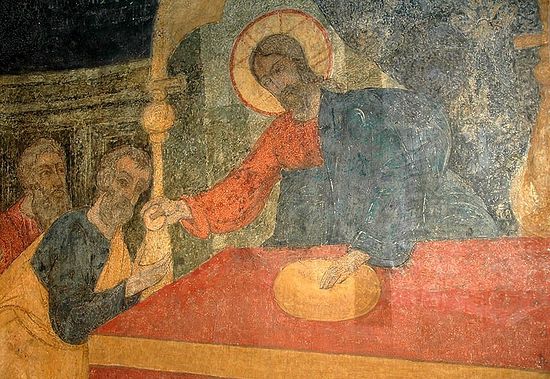 Holy and Great Thursday. The Apostles receiving Communion. Fresco in the Cathedral of the Vladimir Icon of the Mother of God, Sretensky Monastery, Moscow.
Holy and Great Thursday. The Apostles receiving Communion. Fresco in the Cathedral of the Vladimir Icon of the Mother of God, Sretensky Monastery, Moscow. O course He also says, “Do this in remembrance of me.” And people say that means it was a “memorial meal.” But He didn’t say, “Do this in remembrance of me,” but “Do this in remembrance of me”—because the Jews always remembered Moses at Passover time. They remembered their journey out of slavery in Egypt, the slavery under the Egyptians, the physical slavery, and their entrance into the Promised Land of Canaan. But Christ tells His disciples that, “from now on at Passover you will no longer remember Moses, but you will do this, celebrate the Passover, in remembrance of me, of the Christian Passover.” The Greek word “Pascha” is the word Passover. Passover is “Pesach” in Hebrew, “Pascha” in Greek. So we celebrate Passover as Christians, but not the Jewish Passover. We do not remember Moses, we remember the Christian Passover, our deliverance—not from the physical slavery in Egypt, but from the slavery of sin and death; and our entrance—not into the physical land of Canaan, but into the Kingdom of Heaven.
The significance of Friday afternoon
So there is tremendous meaning in the fact that Christ died on Friday afternoon. St. John tells us in his Gospel that John the Baptist and Forerunner points at Christ and calls Him “the Lamb of God.” Why is He the “Lamb of God”? Because at the moment that He was hanging on the cross, from noon to three p.m., at that moment the lambs were being slaughtered in the Temple, the lambs were being sacrificed, the Passover lambs were being sacrificed in the Temple. That’s the reason for remembering the hours on which Christ was hanging on the cross. I can’t even comprehend the depth of the meaning of that mystery. How profound it is that the Lord had us remember His Passion at the time of Passover, the depth of His sacrifice, the meaning of it taking place at that time. Passover now means the entrance into the Kingdom of Heaven, the delivery from the slavery of sin and death. There is so much meaning in it, I don’t have the words to express it. But I will explain to you something amazing that I discovered about the darkness that covered the Earth from the sixth hour until the ninth hour. Those are the hours of darkness, the hours in which the Lord was hanging on the cross. The sixth hour was noon and the ninth hour was 3 p.m. We know that the Jews counted their hours from when the sun rose, basically. The sun rose at the first hour, that was hour number one, and the sixth hour was roughly 12 noon, or when the sun was straight up in the sky. There was no absolute time telling. They didn’t have clocks, so whenever the sun came up that was the first hour, roughly 6 a.m.
The darkness that covered the earth.
What does St. John Chrysostom say about the darkness that took place at the time of the Crucifixion? Now listen to this, and then I’m going to explain it to you. Here’s Chrysostom: “When they had ceased mocking, when they were satiated with their jeerings, and had spoken all that they were minded; then He shows the darkness, in order that at least so (having vented their anger) they may profit by the miracle. For this was more marvelous than to come down from the cross, that being on the cross He should work these things. For whether they thought He Himself had done it, they ought to have believed and to have feared; or whether not He, but the Father, yet thereby they ought to have been moved to compunction, for that darkness was a token of His anger at their crime. For that it was not an eclipse, but both wrath and indignation, is not hence alone manifest, but also by the time, for it continued three hours; but an eclipse takes place in one moment of time.” So you note here that Chrysostom realizes that this was not an eclipse. This was an unnatural event. An eclipse is a natural event.
I want to explain this to you because this is quite fascinating. The earliest known reference to Jesus outside the New Testament is in a work from the first century that has since been lost. Now, you have to follow me carefully as I explain this, but I find this just amazing. There was a first century Greek historian named Thallus, who wrote a three volume history of the Eastern Mediterranean around the year 55—only 20 or 25 years after the Crucifixion. Now this work by this historian Thallus has been lost, but we know about Thallus and that he discussed Jesus and the Crucifixion because a later Christian writer, Julius Africanus, quoted from Thallus in his work called, “History of the World.” Julius Africanus wrote his work around the year 220, so he was a third century Christian author. At the time Julius wrote his book, Thallus’ work obviously still existed. Unfortunately, Julius Africanus’ work, “The History of the World,” has also since been lost. You see, these things written on parchment did not survive antiquity, especially in the East, where after the Muslim conquest, the Islamic invasion, many things were destroyed in the destruction of the cities. So many, many early writings were lost; but even though Julius Africanus’ entire work, “History of the World,” was lost, there was a Byzantine historian, George Synkellos, who wrote around the year 800, and in his work called “Chronicle” or “Chronography,” he quoted Julius talking about Thallus, and that work survives. George Synkellos talks about Thallus’ discussion on the darkness which covered the Earth when Christ was on the Cross. He says the following: “Julius Africanus says Thallus calls this darkness an eclipse of the sun, which seems to be quite wrong.” Now Julius Africanus continues and uses his knowledge of astronomy to explain why this was not an eclipse. It couldn’t have been a solar eclipse because they know when solar eclipses occurred, just as we know we can go back and figure out whether there was a solar eclipse or not, and we can also predict when a solar eclipse will take place in the future. In antiquity they also knew how to do that—they could chart these things. So Africanus goes on to talk about how there was no solar eclipse that year. Synkellos preserved this. Julius Africanus’ point was that the darkness that occurred must have been a supernatural event, not a natural one. The sun inexplicably grew dark, and Julius is contending with Thallus on this point—this is what is important! Thallus was disputing the fact that the darkness that occurred was supernatural. He was saying that the darkness that happened at the time of Christ’s death was merely an eclipse. Now can you understand why that is so important? This is extraordinarily important because Thallus is writing only 20 or 25 years after Christ’s crucifixion. That means that the darkness was a recent, historical event that everyone knew about. Thallus is not disagreeing that it occurred. He doesn’t say “The Christians are full of baloney. There was no darkness on the year that Jesus died.” He doesn’t say there was no darkness. He says that the darkness that happened was an eclipse—you see? But what this tells you is that the details in the Gospel narratives are accurate, because Thallus is not a Christian. He’s a Greek, and he’s trying to dispute Christian claims about Christ. So there was darkness that covered the Earth on the day of Christ’s death! Isn’t that amazing? I find that absolutely amazing.
This was the second installment of the first part of Dr. Jeannie’s discussion on the Crucifixion. In the next part she continues with the last words of Christ and other details of the Crucifixion, including what the Fathers had to say about the spiritual meaning of the Crucifixion.
Presbytera and Dr. Jeannie Constantinou’s podcasts can be found here.
Next The Crucifixion, Part 2. “Into Thy hands do I commit my spirit.”

